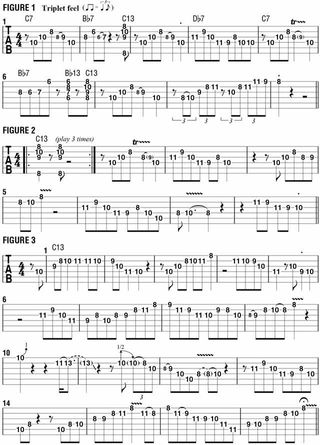Continuing Our Look at Moving "Outside" the Tonal Center
If you develop a taste for moving "outside" the tonal center, it can provide a very cool expansion of your musical vocabulary.

Continuing our look at moving “outside” the tonal center In my last column, I delved into the concept of incorporating an “outside” sound, which, quite literally, means interspersing licks that move beyond the tonal parameters of the established key center.
For example, with a song in the key of Bb, I demonstrated a few ways to move from licks based in Bb to licks one half step higher, in the key of B, which serve as a departure point into a somewhat atonal sound. I then return to licks in Bb and resolve back to the home key.
To some, this will sound “wrong,” but I love the sound of moving up or down a half step out of the home key as a means of creating tension, or “color,” in a solo.
This is certainly not a sound heard often in rock, and when you do hear it, it’s always a bit of a shock. But if you develop a taste for it, as I have, it can provide a very cool expansion of your musical vocabulary.
This month, let’s apply the “outside” concept to a blues shuffle in the key of C. Our first example, illustrated in FIGURE 1, is derived from the playing of the late, great saxophonist Bob Berg, who worked a lot with jazz guitarist Mike Stern. The chord progression alluded to here is C7-Bb7-C7-Db7, as the melodic phrases move down a whole step from C to Bb, and then up one half step from C to Db. The part of this lick I would like to focus on is the phrase in bar 4 that begins in Db but quickly resolves back to C.
In FIGURE 2, I set up a one-chord C7 vamp, and across the ensuing improvisation, I repeatedly move from C up a half step to Db then resolve the improvised melody back to C. Part of the concept here is that I do not shift my fret hand up a fret when moving from C to Db licks; I remain in eighth position, which changes my way of visualizing the phrases on the fretboard in a very useful and effective way. For example, the Gb note on the third string’s 11th fret serves as the flatted fifth of C and also the fourth of Db.
In this way, I’m maintaining a wider view of what’s happening harmonically when I move between the two keys. FIGURE 3 offers a 17-bar improvisation, wherein the line continually shifts between the two keys in a bar-by-bar fashion: bar 1 illustrates a phrase in C based on a C7 arpeggio, built from the notes C E G Bb; bar 2 represents a shift up a half step, with a phrase built from a Db7 arpeggio: Db F Ab Cb (B). In bar 4, I begin in Db and then resolve the phrase to C by the end of bar 5.
As you continue through this solo, be sure to analyze each phrase while also taking notice of the variety of ways in which I’m trying to move seamlessly between the two keys, making the most of the “outside” notes as they come along.

Get The Pick Newsletter
All the latest guitar news, interviews, lessons, reviews, deals and more, direct to your inbox!

Want to play Master of Puppets the right way? Here's how to get faster at downpicking so you can chug like James Hetfield
![Joe Bonamassa [left] wears a deep blue suit and polka-dotted shirt and plays his green refin Strat; the late Irish blues legend Rory Gallagher [right] screams and inflicts some punishment on his heavily worn number one Stratocaster.](https://cdn.mos.cms.futurecdn.net/cw28h7UBcTVfTLs7p7eiLe-840-80.jpg)
“The intensity of Rory’s guitar playing – the emotion, the sound and his incredible attack – was mindblowing for me”: Joe Bonamassa pays tribute to the late, great Irish blues-rock icon Rory Gallagher









